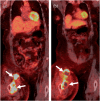Molecular targeted therapies in non-GIST soft tissue sarcomas: what the radiologist needs to know
- PMID: 23649384
- PMCID: PMC3645342
- DOI: 10.1102/1470-7330.2013.0022
Molecular targeted therapies in non-GIST soft tissue sarcomas: what the radiologist needs to know
Abstract
Non-gastrointestinal stromal soft tissue sarcomas are uncommon neoplasms that have a dismal prognosis due to a high incidence of metastases and a poor response to conventional chemotherapy. The identification of characteristic genetic alterations in several of these tumors has opened the window for molecular targeted therapies in patients who have failed conventional chemotherapy. Imaging plays a critical role in assessing the response to these novel therapeutic agents. Just like the response of gastrointestinal stromal tumors to imatinib, the response of non-gastrointestinal stromal soft tissue sarcomas to molecular targeted drugs is better evaluated on imaging by alternate tumor response criteria such as the Choi criteria. In addition, these drugs are associated with distinct class-specific drug toxicities that can come to attention for the first time on imaging. The purpose of this article is to provide a primer for the radiologist on the various molecular targeted therapies in advanced/metastatic non-gastrointestinal stromal soft tissue sarcomas with emphasis on the role of imaging in assessing treatment response and complications.
Figures










Similar articles
-
Frequent mono-allelic loss associated with deficient PTEN expression in imatinib-resistant gastrointestinal stromal tumors.Mod Pathol. 2014 Nov;27(11):1510-20. doi: 10.1038/modpathol.2014.53. Epub 2014 Apr 18. Mod Pathol. 2014. PMID: 24743220
-
[Molecular targeted drugs for soft tissue sarcoma and neuroendocrine tumor].Nihon Rinsho. 2015 Aug;73(8):1398-402. Nihon Rinsho. 2015. PMID: 26281696 Review. Japanese.
-
Imatinib mesylate: in the treatment of gastrointestinal stromal tumours.Drugs. 2003;63(5):513-22; discussion 523-4. doi: 10.2165/00003495-200363050-00005. Drugs. 2003. PMID: 12600228 Review.
-
[Systemic therapy of soft tissue sarcomas].Pathologe. 2011 Feb;32(1):65-71. doi: 10.1007/s00292-010-1397-8. Pathologe. 2011. PMID: 21053001 Review. German.
-
New strategies for treating GIST when imatinib fails.Cancer Invest. 2007 Aug;25(5):328-35. doi: 10.1080/07357900701206273. Cancer Invest. 2007. PMID: 17661208
Cited by
-
Primary myxoid liposarcoma of the pelvis: An unusual location.Radiol Case Rep. 2020 Feb 15;15(4):431-434. doi: 10.1016/j.radcr.2020.01.020. eCollection 2020 Apr. Radiol Case Rep. 2020. PMID: 32089761 Free PMC article.
-
Current Concepts in Non-Gastrointestinal Stromal Tumor Soft Tissue Sarcomas: A Primer for Radiologists.Korean J Radiol. 2017 Jan-Feb;18(1):94-106. doi: 10.3348/kjr.2017.18.1.94. Epub 2017 Jan 5. Korean J Radiol. 2017. PMID: 28096721 Free PMC article. Review.
-
MRI, MDCT features, and clinical outcome of extremity leiomyosarcomas: experience in 47 patients.Skeletal Radiol. 2014 May;43(5):615-22. doi: 10.1007/s00256-014-1823-8. Epub 2014 Feb 5. Skeletal Radiol. 2014. PMID: 24496586
-
Imaging features of primary and metastatic alveolar soft part sarcoma: single institute experience in 25 patients.Br J Radiol. 2014 Apr;87(1036):20130719. doi: 10.1259/bjr.20130719. Epub 2014 Feb 17. Br J Radiol. 2014. PMID: 24641199 Free PMC article.
-
Reversion of Hormone Treatment Resistance with the Addition of an mTOR Inhibitor in Endometrial Stromal Sarcoma.Case Rep Med. 2014;2014:612496. doi: 10.1155/2014/612496. Epub 2014 Jul 8. Case Rep Med. 2014. PMID: 25104960 Free PMC article.
References
-
- Demetri GD, Antonia S, Benjamin RS, et al. Soft tissue sarcoma. J Natl Compr Cancer Network. 2010;8:630–674. - PubMed
Publication types
MeSH terms
Substances
LinkOut - more resources
Full Text Sources
Other Literature Sources
Medical
